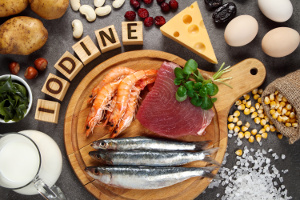The increasing PFAS pollution disrupts the body’s iodine utilization and hormone balance
 PFAS (per- and polyfluoroalkyl substances) are found in building materials, textiles, kitchen utensils, foam from fire extinguishers, and cosmetics. The compounds have even been found in certain foods. The massive PFAS pollution may impair the body’s ability to utilize iodine, especially by affecting thyroid hormones that are essential for our metabolism, according to an article published in Molecular and Cellular Endocrinology. Daily exposure to PFAS may also increase the risk of fetal damage, poor liver function, breast cancer, and other diseases. It also appears that PFAS poisoning increases the need for iodine.
PFAS (per- and polyfluoroalkyl substances) are found in building materials, textiles, kitchen utensils, foam from fire extinguishers, and cosmetics. The compounds have even been found in certain foods. The massive PFAS pollution may impair the body’s ability to utilize iodine, especially by affecting thyroid hormones that are essential for our metabolism, according to an article published in Molecular and Cellular Endocrinology. Daily exposure to PFAS may also increase the risk of fetal damage, poor liver function, breast cancer, and other diseases. It also appears that PFAS poisoning increases the need for iodine.
PFAS (per- and polyfluoroalkyl substances) are chemical fluoride compounds that are difficult to break down and therefore tend to accumulate in the surrounding environment. They also tend to accumulate in animals and humans. PFAS can be measured in the blood in people across the globe. The higher the concentrations, the greater the risk of serious health complications.
Danish waterworks are constantly being screened for the presence of PFAS. In case they are found in a reservoir, it is normally shut down. Alternatively, measured are taken to make sure the PFAS content in the water is within the threshold values. However, we also get exposed to PFAS from other sources such as concrete, paint, furniture, electronic components, carpets, rain clothes, ski clothing, lacquer, non-stick kitchen utensils, baking paper, creams, wax, dental floss, foam from fire extinguishers, and animal fodder.
- PFAS is a collective term for thousands of different synthetic fluoride-containing compounds co
- There are several subgroups (PFOS, PFOA, PFNA, and PFHxS)
- The carbon-fluorine bond is what makes the compounds water- and grease-repellant
- The compounds are very stable and difficult to break down
Why are PFAS so bad for you?
According to an article that is published in Molecular and Cellular Endocrinology, PFAS are able to interact with proteins in the body and the phospholipids in our cell membranes. That way, PFAS can accumulate in the body and in the food chain. PFAS can also enter the cells of the thyroid gland and block the uptake of iodine, which the thyroid gland needs in order to produce the two thyroid hormones, T4 (with 4 iodine atoms) and T3 (with 3 iodine atoms). The ovaries are also known to contain larger quantities of iodine, just like the thyroid gland. By blocking the uptake of iodine, PFAS can cause changes to the estrogen production in the ovaries and in the estrogen receptors of the breast cells. Human exposure to PFAS is believed to be linked to a host of different health problems, including thyroid disorders, infertility problems, fetal damage, impaired immune defense, liver damage, cholesterol imbalances, and certain cancer forms, including breast cancer.
As PFAS interacts with iodine, it is important to make sure to get enough iodine every day.
Iodine sources and the need for iodine
Iodine is mainly found in seaweed, fish, shellfish, and fish sauce. It is also found in eggs and dairy products. The iodine content in agricultural soil varies quite a lot, and that is reflected in the iodine content in crops. In Denmark, where the iodine intake used to be below the internationally recommended intake level, it is compulsory to enrich table salt with iodine. Many people prefer not to use regular table salt because it contains an anti-caking agent with aluminum, and sea salt does not contain enough iodine to cover the daily need. Therefore, the iodine intake is believed to be too low – especially among pregnant women. Also, PFAS appear to increase the need for iodine.
The officially recommended daily iodine intake is 150 micrograms for adults. According to leading scientists, however, we need as much as two to five mg daily for optimal coverage. This dose is equivalent to the safe upper intake level that has been established by FAO (the Food and Agriculture Organization of the United Nations).
Iodine content in micrograms (per 100 grams of food)
- Seaweed, dried (kombu, agar) 36,000
- Iodine-enriched table salt 1,560
- Lobster, raw 700
- Fish and cod roe 30-250
- Mussels 140
- Whole eggs 65
- Fruit and vegetables 0.2 – 1.0
References
Amalia Conti et al. Perfluoroocotane sulfonic acid, a persistent organic pollutant, inhibits iodide accumulation by thyroid follicular cells in vitro. Molecular and Cellular Endocrinology 2020
Frederick R. Stoddard et al. Iodine Alters Gene expression in the MCF7 Breast Cancer Cell Line: Evidence for an Anti-Estrogen Effect of Iodine. International Journal of Medical Sciences. 2008
PFAS - Sundhedsstyrelsen
Frida - Grupperet fødevareliste (fooddata.dk)
Search for more information…
- Created on .








